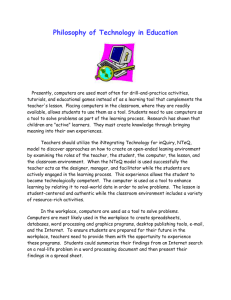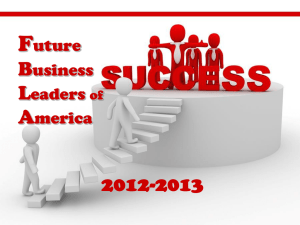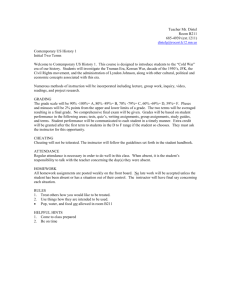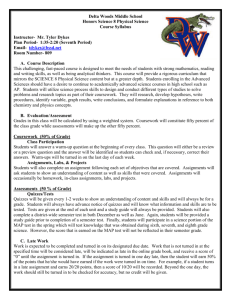1449 Office Management Instructional Guide
advertisement
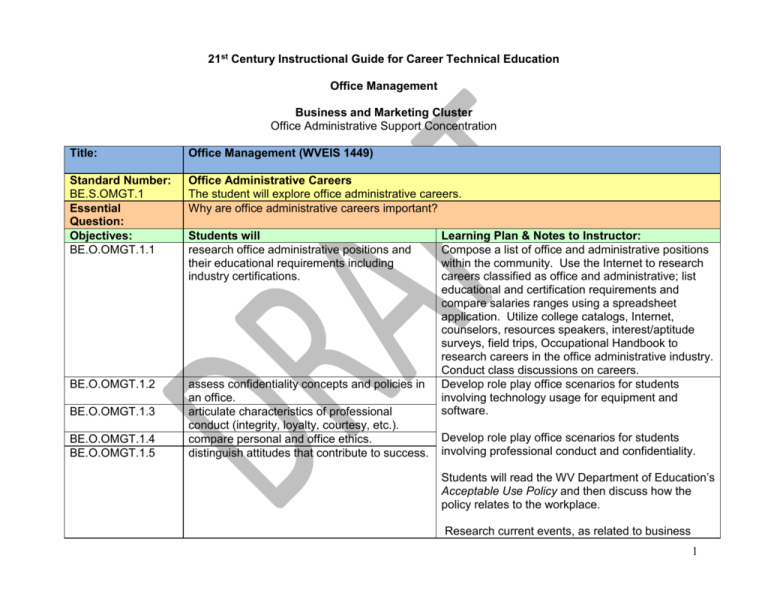
21st Century Instructional Guide for Career Technical Education Office Management Business and Marketing Cluster Office Administrative Support Concentration Title: Office Management (WVEIS 1449) Standard Number: BE.S.OMGT.1 Essential Question: Objectives: BE.O.OMGT.1.1 Office Administrative Careers The student will explore office administrative careers. Why are office administrative careers important? BE.O.OMGT.1.2 assess confidentiality concepts and policies in an office. articulate characteristics of professional conduct (integrity, loyalty, courtesy, etc.). compare personal and office ethics. distinguish attitudes that contribute to success. BE.O.OMGT.1.3 BE.O.OMGT.1.4 BE.O.OMGT.1.5 Students will research office administrative positions and their educational requirements including industry certifications. Learning Plan & Notes to Instructor: Compose a list of office and administrative positions within the community. Use the Internet to research careers classified as office and administrative; list educational and certification requirements and compare salaries ranges using a spreadsheet application. Utilize college catalogs, Internet, counselors, resources speakers, interest/aptitude surveys, field trips, Occupational Handbook to research careers in the office administrative industry. Conduct class discussions on careers. Develop role play office scenarios for students involving technology usage for equipment and software. Develop role play office scenarios for students involving professional conduct and confidentiality. Students will read the WV Department of Education’s Acceptable Use Policy and then discuss how the policy relates to the workplace. Research current events, as related to business 1 ethics, found in magazines, newspapers, and online to use in class discussions and debates. Students will debate the issues of ethics, confidentiality, and private information as related to office administrative position. Students will create lists of what they understand to be professional and unprofessional conduct and discuss the lists and compare them to standard business conduct. Utilize multimedia to emphasize professional and ethical conduct. BE.O.OMGT.1.6 recognize the different types of organizations (not-for-profit entities, governmental, etc.). Invite a guest speaker from the community who is considered to be a model business person. Students will research the Internet for the different type of organization structures. Students will post their responses to a blog and respond to at least two other postings. Students will compile a list of organizations within their community and school. The list should state what type of organizations it is along with a brief description and contact information. Standard Number: BE.S.OMGT.2 Essential Question: Objectives: BE.O.OMGT.2.1 BE.O.OMGT.2.2 Communication Skills The student will communicate effectively in a professional and personal manner. What is communications? Students will create and maintain effective and productive work relationships. develop efficient office team relationships. Learning Plan & Notes to Instructor: Students will be complete a simulation that will include prioritizing tasks individually and in teams. Students will develop lists on the pros and cons of teamwork. Students will share their lists with the 2 class for discussion to compose a master list. Students will research benefits of the teamwork approach (pros and cons) and prepare a short presentation and report. Students will blog their teacher on the research findings for the presentation or short report. BE.O.OMGT.2.3 compose business correspondence. The teacher can divide the class into groups. Each group would receive an effective and ineffective approach to teamwork to role play for their peers. The students will then evaluate each scenario. Provide students with a list of office tasks to complete; students will prioritize the list; from the list provide students with web sites, electronic document files, financial statistics, and an address book. Students will use the information to prepare business correspondence to submit electronically to the teacher. Students will create correspondence that could include e-mails, business letters, and memos for peer review. Utilize online grammar sites for grammar drills for choosing correct word(s). Teacher can use interactive media for demonstration, (i.e whiteboards, ABTutor, NetOP School). Teacher creates daily office task list to include a handwritten letter, retrieval of an electronic file from a wiki, and an unedited short report. Each office task will come with instructions for students to follow to prioritize, format, and edit. Students should submit completed assignments electronically to the 3 BE.O.OMGT.2.4 BE.O.OMGT.2.5 BE.O.OMGT.2.6 produce multiple copies and distribute documents and information. simulate placing and receiving telephone calls including conference calls. prepare written telephone messages. teacher. Use proofreading guidelines to edit inaccurate business documents. Students will compare and contrast the specifications of different office copy machines. Students will discuss in groups and then present to the class the most effective copy machine for the office and the classroom. Students will determine the cost of printed copy versus electronic distribution (web sites, wikis, email, etc). Students should discuss the most effective method of sending particular documents to business associates within and out of the office. Discuss the various aspects of telephone etiquette. Aspects of telephone etiquette to discuss might be: Incoming calls telephone voice pronunciation enunciation tone making a good impression exhibiting courtesy giving undivided attention putting a call on hold handling different situations remembering caller’s names checking for understanding communicating feeling ending the conversation Outgoing calls plan ahead double-check the number allow sufficient time for an answer identify yourself be prepared 4 BE.O.OMGT.2.7 process incoming and out-going mail including electronic mail. Students can role-play a variety of situations they may face in using the telephone in an office. Students can critic the role play to discuss do’s and don’ts. Invite the local Postmaster to discuss mailing rules, regulations and processes. Students can discuss ethics involved with processing and distributing office mail. Tour a postal processing facility. Research netiquette rules for electronic mail. Discuss the rules and how they apply in the office. Conduct discussions and use interactive media for the following: incoming mail sorting recording annotating distributing outgoing mail sign letters prepare envelopes folding and inserting using least expensive/most efficient method o first-class o second-class o third-class o fourth-class o priority o express o special delivery o certified mail o registered mail 5 BE.O.OMGT.2.8 examine emerging telecommunications. Research the Internet for product information relating to emerging telecommunication. Invite a representative from a wireless provider to be a guest speaker. Invite a representative from a landline provider to be a guest speaker. Standard Number: BE.S.OMGT.3 Essential Question: Objectives: BE.O.OMGT.3.1 BE.O.OMGT.3.2 BE.O.OMGT.3.3 BE.O.OMGT.3.4 Workstation Management and Office Safety The student will demonstrate the management of a safe office system. What is a safe office system? Students will maintain workstations, equipment, materials, and supplies. recognize workstation safety. compare and contrast ergonomic factors and their relationship to office health and wellness. provide information on office safety precautions. Learning Plan & Notes to Instructor: Students will create a media presentation on the various ergonomic principles and/or equipment found in an office. Students will research the latest technologies related to ergonomics and blog their responses on a teacher created blog. Students should respond to two additional blogs. Invite a physical therapist, personal trainer, or other medical personnel as a guest speaker to discuss ergonomic factors for office health and wellness. Students will role play unsafe work habits. Students will tour the business and marketing education classrooms and use a checklist to determine safe and unsafe working conditions. Standard Number: BE.S.OMGT.4 Essential Question: Financial Management Components The student will prepare and manage financial components. What are financial components? 6 Objectives: BE.O.OMGT.4.1 Students will prepare banking transactions (check writing, deposit slips, reconcile bank statement, etc.). Learning Plan & Notes to Instructor: The teacher will obtain a banking simulation from the local bank or the State Treasurer’s office. Teacher will prepare a list of business transactions for students to practice writing checks and maintaining a check register. Teacher will prepare a list of bank deposit slips, bank reconciliation and check registers to demonstrate to students using interactive media. BE.O.OMGT.4.2 BE.O.OMGT.4.3 manage petty cash funds and cash advance accounts. Students will role play a petty cashier by using a money box with petty cash slips. prepare payroll records. Students will discuss ethical and unethical uses of petty cash. Students will use the Internet to research the different methods of pay and prepare a short presentation to share with the class. Invite a payroll clerk or accountant to discuss payroll procedures. Students will investigate the IRS and Federal Reserve websites for payroll information. The teacher will generate a template for students to complete an office simulation for payroll. Payroll records should include: tax identification numbers employee payroll information sheets employees’ earnings (gross and net) prepare paychecks employees’ earnings records payroll register 7 BE.O.OMGT.4.4 develop a personal budget. calculate and file taxes Students will journalize payroll transactions for the office simulation. The teacher will create a scenario for students to develop a personal budge based on specified amount of income per month. The teacher will set guidelines for the information to be included in the budget. Students will e-mail their completed budgets to the teacher. The teacher will present a monthly net salary to the class for students to determine what expenses can be paid. BE.O.OMGT.4.5 BE.O.OMGT.4.6 utilize purchase requisitions, purchase orders and vouchers for payment. differentiate between a balance sheet and an income statement. Use interactive media to compile a list wants and needs Teachers will use a document cam for students to identify invoices, receipts, purchase orders, vouchers, and other payment documents. Students can use responders to answer questions related to the documents. Teacher will illustrate the terms of payment on documents and explain the difference between a requisition and purchase order. The teacher will use interactive media to illustrate the difference between a balance sheet and an income statement. The teacher will generate an unarranged balance sheet and income statement for the students to complete. List the accounts to be used for students assignment using interactive media and students will use responders to designate income statement or 8 balance sheet. Standard Number: BE.S.OMGT.5 Essential Question: Objectives: BE.O.OMGT.5.1 BE.O.OMGT.5.2 BE.O.OMGT.5.3 BE.O.OMGT.5.4 BE.O.OMGT.5.5 BE.O.OMGT.5.6 Information Management The student will prepare and manage information. Why file? Students will control an alphabetical filing system and retrieve information from files. implement a subject filing system and retrieve information from files. establish a numerical filing system and retrieve information from files. demonstrate chronological filing system and retrieve information from files. recognize tickler file system and retrieve information from files. demonstrate filing systems electronically and manually. Learning Plan & Notes to Instructor: Use interactive media to present and discuss the following filing rules: alphabetic individual names prefixes hyphenated names abbreviated names titles and degrees married women business names identical names numeric master list or accession record chronological date of receipt date of creation time of creation tickler to do lists pending statements unpaid invoices travel follow-up reminders Prepare index cards using a variety of names or numbers and have students place them in the proper order. Do this activity electronically. Standard Number: Information Processing 9 BE.S.OMGT.6 Essential Question: Objectives: BE.O.OMGT.6.1 BE.O.OMGT.6.2 BE.O.OMGT.6.3 BE.O.OMGT.6.4 BE.O.OMGT.6.5 BE.O.OMGT.6.6 BE.O.OMGT.6.7 BE.O.OMGT.6.8 BE.O.OMGT.6.9 The student will accurately and efficiently prepare and process office information Why is accuracy important? Students will format documents (agendas, statistical documents, correspondence, etc.). incorporate touch system of entry on calculators and 10-key pads. transcribe dictation from recorded media (correspondence, reports, minutes of meetings, etc.). enhance formatting of documents (clip art, borders, shading, etc). create and format tables and charts. perform a variety of word processing functions (merge text, sort data, search/replace data, etc.). develop text editing and proofreading skills. use a variety of resources for editing (i.e. online help, Web tools, technical manuals, etc.). process documents electronically (i.e. e-mail, blogs, wikis, Web pages, etc.). Learning Plan & Notes to Instructor: Students will create documents from selected rough drafts (i.e. letters, memos, etc.). Students can prepare documents (handwritten or keyed) to exchange and key with corrections. The teacher will create a podcast of a mini lecture and students will listen and transcribe notes on it. The students will create a one-to-two minute podcast for use by other students to take and transcribe notes. Teacher demonstration on the correct 10-key pad entry system. Students will practice the correct techniques. Students will use a format guide, such as the FBLA Format Guide, to key business documents. Students will complete a simulation that will include prioritizing tasks. Students will use formatting tools to enhance the documents created in the projects within the simulation. Peers will evaluate the documents for errors – spelling, grammatical, and formatting. Students will correct documents before submitting to the teacher electronically for evaluation – via email, wiki, blog, etc. Simulations can be found online, purchased through publishing companies, or teacher created. Standard Number: Organizing and Planning 10 BE.S.OMGT.7 Essential Question: Objectives: BE.O.OMGT.7.1 BE.O.OMGT.7.2 BE.O.OMGT.7.3 BE.O.OMGT.7.4 BE.O.OMGT.7.5 The student will demonstrate organizing and planning procedures. Why is planning important? Students will create and analyze time management data. coordinate meetings, events, and travel arrangements related to the office including online resources. provide and follow written and oral directions. design a calendar of events. research electronic organizers, software, and technologies for organizing and planning. Learning Plan & Notes to Instructor: Invite a meeting planner to discuss planning meetings. Related topics or guidelines to discuss might be: verify date and time of meeting know number of attendees determine duration of meeting identify purpose of meeting arrange for a meeting room obtain necessary equipment notify attendees develop an agenda appoint someone to take minutes Students will be provided information to format an agenda using a word processing program; a template may be used if desired. Use interactive media to show examples of different styles of meeting and travel agendas. Invite a travel agent as a speaker. Students can research the Internet to compare and contrast the various modes of transportation for an employer to attend an out-of-state conference. All information can be recorded in a spreadsheet. Students will be given a scenario for preparing the travel and hotel accommodations for their employer to attend a business conference. Travel plans will need to include car rental fees. Once these items are decided, the students will need to prepare a travel itinerary beginning day of departure to day of return. 11 Students will role play giving oral and written directions from their school to other points of interest within their communities. Students will create a calendar or use Outlook or another calendar based software to prioritize their assignments, due dates, and appointments. Standard Number: BE.S.OMGT.8 Essential Question: Objectives: BE.O.OMGT.8.1 BE.O.OMGT.8.2 BE.O.OMGT.8.3 Human Relationship Skills The student will recognize human relations skills How are human relations skills used? Students will assess personality traits that are critical for effective performance at work. evaluate the attitudes that contribute to the success of organizations. Learning Plan & Notes to Instructor: Students will conduct a survey for workplace performance. The survey will be distributed to classmates, teachers and local businesses. Compare and contrast the results of the survey. appraise expectations related to appearance and manners at work. Compile a list of employee attitudes that contribute to a successful workplace. Compile a list of employee attitudes that contribute to an unsuccessful workplace. Discuss how you can correct the employees’ unsuccessful attitudes to change for being successful. Relate this information to the classroom. Invite a Personnel Director to speak on appropriate and inappropriate dress and manners. Students can role play appropriate and inappropriate workplace dress and manners BE.O.OMGT.8.4 interpret what effective interaction with others at work means. Students will debate business casual versus business professional dress for work. Explore workplace policies related to harassment. List, define, and discuss the different forms of harassment. Students will role play office interaction scenarios. 12 BE.O.OMGT.8.5 BE.O.OMGT.8.6 BE.O.OMGT.8.7 differentiate between appropriate and inappropriate responses in conflicts at work. assess the ability to work with others. interpret some basic laws and regulations that apply to the workplace. Students will research and discuss body language. Students will research effective conflict resolution utilizing the Internet and/or other resources. Students will prepare a short report or presentation, using the media software of their choice, of their findings and present to the class or other career and technical classes. Students will role play effective methods of resolutions to conflict. After each role play, students will critique and agree or disagree on the resolution Contact local business and industries to obtain copies of employee handbooks. Review the handbooks. Invite the Personnel Director of the local Board of Education, or other business, to discuss workplace laws and regulations. Standard Number: BE.S.OMGT.9 Essential Question: Objectives: BE.O.OMGT.9.1 BE.O.OMGT.9.2 BE.O.OMGT.9.3 BE.O.OMGT.9.4 BE.O.OMGT.9.5 BE.O.OMGT.9.6 BE.O.OMGT.9.7 Employability Skills The student will facilitate effective employability skills What are employability skills? Students will devise a career plan and professional growth plan. design a resume. develop an electronic portfolio to be used for employment. incorporate personal data into a job application form and write a letter of application. communicate successful interviewing techniques. compile a list of steps to follow in resigning from a position. examine methods for soliciting letters of Learning Plan & Notes to Instructor: Students will research their career choice and prepare an short report to include information on educational requirements, job description, salary, and future plans for employment growth within the business. Students will present their career choice report to the class or post the report to a teacher generated blog or wiki. Students will research local newspapers and the Internet for medical business positions. Utilize Internet sites such as Monster.com, CareerBuilders.com or online newspapers. Ask local businesses for a copy of their application 13 BE.O.OMGT.9.8 recommendation. break down and analyze an employee performance evaluation. forms and/or use the job application form found in the FBLA Chapter Management Handbook. Students will practice completing job application forms manually and computerized. Use interactive media to show examples of cover letters and resume styles. Students will compose a cover letter and resume. Students will create a digital portfolio. Using role play, create a scenario for students to practice interviewing skills used in the employment process. Students will use the cover letter and resume or digital portfolio that was created for Objectives 9.2, 9.3 and 9.4. Students will compose a follow-up letter, letter of refusal for a job offer, and letter of resignation. Standard Number: BE.S.OMGT.10 Essential Question: Objective Number: BE.O.OMGT.10.1 Participating in the student organization Students will participate in the local chapter of a student organization. What are the benefits of a career, technical student organization? BE.O.OMGT.10.2 discover the benefits and responsibilities of participation in student organization as an adult. Students will assess the purposes and goals of the local student organization. Learning Plan & Notes to Instructor: Invite students to participate in an FBLA chapter event. Invite State FBLA Officer to present at a chapter meeting or to a class on the activities, purpose and benefits of membership. Show the FBLA promotional video located on www.FBLAPBL.org web site. Have students to locate and discuss the FBLA-PBL goals, mission statement, and pledge. Invite FBLA-PBL alumni members to be guest speakers in the classroom and during chapter events. Coordinate a chapter event with another 14 BE.O.OMGT.10.3 21st Century Skills Information and Communication Skills: service organization in the community (such as Lion’s Club, Women’s Club, Jaycees, Rotary, etc.). demonstrate leadership skills through Have the local FBLA officer team to develop a participation in student organization activities program of work for the school year and form various such as meetings, programs, and projects. committees to complete the task using chapter members. Encourage students to actively participate in State, regional, and national conferences and vie for leadership positions. Learning Skills & Technology Tools Teaching Strategies Evidence of Success Culminating Activity 21C.O.9Student recognizes Students use search engines Students identify job 12.1.LS1 information needed for to investigate employment possibilities and problem solving, can opportunities. recognize applicable efficiently browse, search, networking possibilities and navigate online to access Students will use search and pertinent relevant information, engines to research professional evaluates information based networking and professional organizations. on credibility, social, organization opportunities. economic, political and/or ethical issues, and presents findings clearly and persuasively using a range of technology tools and media. 21C.O.9Student creates information Students complete Completed projects are 12.1.LS3 using advanced skills of multimedia presentations. judged based on analysis, synthesis and Business Presentation evaluation and shares this Performance Rating information through a variety sheet from the FBLA of oral, written and multimedia Chapter Management communications that target Handbook or teacher academic, professional and created rubric. technical audiences and purposes. 21C.O.9Student routinely applies Students will utilize Microsoft Completed assignments. 12.1.TT2 keyboarding skills, Word, PowerPoint, and keyboarding shortcut Excel on a routine basis to 15 Thinking and Reasoning Skills: 21C.O.912.2.LS3 21C.O.912.2.TT3 Personal and Workplace Skills: 21C.O.912.3.TT2 21C.O.912.3.LS3 techniques, and mouse skills with facility, speed and accuracy. Student engages in a problem solving process by formulating questions and applying complex strategies in order to independently solve problems. Student uses multiple electronic sources of information and multiple technology tools and resource tools (e.g., digital cameras, graphing calculators, probes, mp3 players, handheld devices, other emerging technologies, simulations, models, browsers, word processing, authoring tools, spreadsheets, databases) to collaborate with others, to formulate a hypothesis, to solve problems, make decisions, and present and justify the solutions. Student works collaboratively to acquire information from electronic resources, conducts online research, and evaluates information as to validity, appropriateness, usefulness, comprehensiveness and bias. Student demonstrates ownership of his/her learning complete assignments. Students will use problem Completed assignments. solving skills to decide on the appropriate software to use in completing specific assignments and projects. Students will utilize a variety of tools to complete assignments. Students will conduct research selecting sources from an approved list. They will utilize rubrics to evaluate the validity, bias, appropriateness, usefulness, and comprehensiveness of the sites. Student will set personal goals and continually Completed research rubric and/or report. Observation of personal growth. 16 by setting goals, monitoring and adjusting performance, extending learning, using what he/she has learned to adapt to new situations, and displaying perseverance and commitment to continued learning. 21C.O.9Student adheres to 12.3.TT4 acceptable use policy and displays ethical behaviors related to acceptable use of information and communication technology (e.g., privacy, security, copyright, file-sharing, plagiarism); student predicts the possible cost and effects of unethical use of technology (e.g., consumer fraud, intrusion, spamming, virus settling, hacking) on culture and society; student identifies the methodologies that individuals and businesses can employ to protect the integrity of technology systems. Learning Skills & Technology Tools Entrepreneurial Skills: D Understand concepts, strategies, and systems needed to interact effectively with others. evaluate and adjust to demonstrate increased awareness of life-long learning. Students will sign and adhere to a school-wide acceptable use policy. Ethical use of technology. Teaching Strategies Evidence of Success Culminating Activity Students will develop Observation of personal leadership, personal growth. management, communication, and job seeking skills as they engage in work assignments. 17 E H I Culminating Assessment: Student understands concepts and procedures needed for basic computer operations. Understand concepts and strategies needed for career exploration, development, and growth. Understands the processes and systems implemented to facilitate daily business operations. Students will utilize computer Completed assignments. software and hardware to complete assignments. Students successfully utilize job seeking skills as they build a professional portfolio. Completed digital portfolio. Students will demonstrate Observation and the skills necessary to completed assignments.. effectively manage the day to day operations of an office. Culminating Assessment: Sarah is the Assistant manager at a specialty furniture and accessories stores. Julia and Cathy are assistant managers with Sarah. Each assist manager is in charge of a work shift with three associate sales staff members. The assistant managers often work shifts with Brad, the store manager. Part of Sarah’s job responsibilities includes preparing the employees 14-day work schedules. When the schedule is complete, Sarah reviews the schedule with the manager and assistant managers before distributing and posting it to the employees. When the new schedule is posted, the previous schedule is verified by the assistant manager in charge of scheduling and then signed by the manager. After the schedule is verified it is submitted to the companies’ regional office. The Assistant Managers have noticed unusual behavior from Brad, the store manager. Brad is often late for work, takes extra time for lunches and breaks, and often alters his work hours on the schedule. The associate sales staff has discussed Brad’s unethical and unusual behavior with the assistant managers. Sarah, Julia and Cathy listened to the associate sales staff, and have concerns with these comments about Brad. 1. Unethical and unprofessional comments about other employees and customers. 2. Purchasing store merchandise utilizing the employees discount for friends using that person’s credit card. Sarah, Julia and Cathy have also noticed the changes in Brad’s hours worked each week. Brad is working less hours but falsifying his work schedule to reflect a full 40 hour week. Sarah is particularly concerned since she is responsible for verifying the work schedule with all employees prior to 18 submitting it to the regional office. Sarah does not want to get reprimanded or lose her job. What action should Sarah, Julia and Cathy take to resolve this problem? Consider these points when researching, and or role playing, the case study. Should employees be allowed to abuse their work time? Is it proper to abuse company time? How do the actions of the Store Manager affect the other employees? Do the actions of the Store Manager affect customers? What do you want to suggest about how the Assistant Store Mangers should precede with this problem? What, if anything, should be said to the associate sale staff members? What, if anything, should be said to the company’s regional managers? If the Store Manager continues his work habits, are there legal ramifications or concerns? FBLA Competitive Events Links and Other Resources: End-Of-Concentration Performance Assessment Links and Other Resources Related Websites: United States Postal Service www.usps.com Videos to Upload www.viddler.com Blogging www.blogger.com Wetpaint www.wetpaint.com Dictionary http://dictionary.reference.com/others 19 Filing Procedures and Rules article http://findarticles.com/p/articles/mi_qa3691/is.../ai_n8724717/ Class Chatter www.classchatter.com Federal Communications Commission (FCC) www.fcc.gov Pathways to Success http://careertech.k12.wv.us/pathwaystosuccess/ U.S. Department of Labor in the 21st Century http://www.dol.gov/ America's Career InfoNet www.acinet.org America's Job Bank www.ajb.org America's Service Locator www.servicelocator.org Employment & Training Administration www.doleta.gov Monthly Labor Review Online: Labor Force Archives http://www.bls.gov/opub/mlr/indexL.htm#Labor force Occupational Information Network www.doleta.gov/programs/onet Office of Disability Employment Policy www.dol.gov/odep Workforce West Virginia 20 https://www.workforcewv.org/ West Virginia Earn A Degree Graduate Early (EDGE) http://www.wvtechprep.wvnet.edu/edge.htm West Virginia Career and Technical Education http://careertech.k12.wv.us/ Newsweek www.newsweek.com Time www.time.com USA Today www.usatoday.com Contacts: Contacts Business Teachers: Utilize K12 Business Marketing Listserv at K12-BUSMKT@listserv.wvnet.edu Business Coordinator: Abby Reynolds, areynold@access.k12.wv.us OCTI Assistant Executive Director: Donna Burge-Tetrick OCTI Executive Director: Gene Coulson 21
